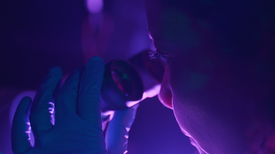From symptoms to vaccines and treatment, here are some fast facts about monkeypox.
Tanya Lewis: Monkeypox, a virus that was previously endemic to sub-Saharan Africa, is now spreading around the world. So what do we know about the outbreak so far? To find out, I talked to an expert who has been studying monkeypox for more than two decades.
Anne Rimoin: At the beginning, we didn't have any surveillance. Now that people are looking for monkeypox, they're starting to find it.
Lewis: The virus is thought to spread primarily through close contact—whether that’s skin-to-skin, through contact with contaminated objects such as clothing, and through respiratory droplets at close range. Most of the known cases in the current outbreaks outside of Africa have been in men who have sex with men. But it’s important to note that anyone can get the virus through close contact. It’s also not necessarily transmitted through sex.
Rimoin: It’s important not to stigmatize anybody. This virus has been spreading in communities in sub- Saharan Africa for a long time. And it's not particular to any gender or any orientation. It's just about close contact.
Lewis: There is no evidence yet that the virus can spread through aerosols that hang in the air and travel over long distances, unlike SARS-CoV-2, the virus that causes COVID.
Rimoin: These are two very different kinds of viruses. So monkeypox is a DNA virus—it’s much more stable—whereas SARS-CoV-2 is an RNA virus. SARS-CoV-2 is one of [the] most infectious viruses on the planet. Monkeypox is not as contagious.
Lewis: The symptoms of monkeypox are a characteristic pimple or blisterlike rash, accompanied by flulike symptoms such as fatigue, fever or swollen lymph nodes. In the past, monkeypox often presented as a rash over the whole body, often starting on the face. But in the current outbreak, the rash appears to be more localized to the genitals, and some people have mild or no other symptoms. If you have these symptoms, or have reason to suspect you may have been exposed to monkeypox, you should see your health care provider and get tested. Patients and providers need to be aware of the virus so that we’re not missing cases. The good news is there are treatments and vaccines available. There’s an antiviral called TPOXX, and there are two vaccines: There’s the ACAM2000 smallpox vaccine, which also works for monkeypox but shouldn’t be used in people with some health conditions. And there’s a newer vaccine called JYNNEOS. The U.S. has a limited supply of JYNNEOS but is in the process of ordering more. The vaccines can be given prophylactically to those most at risk, and also after exposure to the virus. But we need to act quickly.
Rimoin: The stakes are high—we could see monkeypox establishing itself in humans with, you know, regular human-human transmission, or we could see, potentially, a spill back into animal populations. And if we do see a spill back into animal populations, it’s going to make the situation much more complicated.
Lewis: There are still so many unknowns about the current outbreak. But one thing’s for certain.
Rimoin: We should be humble about what we know and be ready to understand how this virus might be different in this context.








